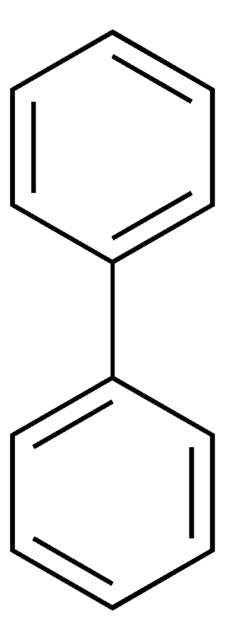W312908
Biphenyl
≥99%
About This Item
Prodotti consigliati
Origine biologica
synthetic
Livello qualitativo
agenzia
meets purity specifications of JECFA
Densità del vapore
5.31 (vs air)
Tensione di vapore
9.46 mmHg ( 115 °C)
Saggio
≥99%
Forma fisica
flakes
powder or crystals
Temp. autoaccensione
1004 °F
Limite di esplosione
0.6 %, 111 °F
5.8 %, 166 °F
P. eboll.
255 °C (lit.)
Punto di fusione
68-70 °C (lit.)
applicazioni
flavors and fragrances
Documentazione
see Safety & Documentation for available documents
Allergene alimentare
no known allergens
Organolettico
geranium; green
Stringa SMILE
c1ccc(cc1)-c2ccccc2
InChI
1S/C12H10/c1-3-7-11(8-4-1)12-9-5-2-6-10-12/h1-10H
ZUOUZKKEUPVFJK-UHFFFAOYSA-N
Informazioni sul gene
human ... CYP1A2(1544) , ESR1(2099)
Cerchi prodotti simili? Visita Guida al confronto tra prodotti
Descrizione generale
Esclusione di responsabilità
Avvertenze
Warning
Indicazioni di pericolo
Consigli di prudenza
Classi di pericolo
Aquatic Acute 1 - Aquatic Chronic 1 - Eye Irrit. 2 - Skin Irrit. 2 - STOT SE 3
Organi bersaglio
Respiratory system
Codice della classe di stoccaggio
13 - Non Combustible Solids
Classe di pericolosità dell'acqua (WGK)
WGK 2
Punto d’infiammabilità (°F)
230.0 °F - closed cup
Punto d’infiammabilità (°C)
110 °C - closed cup
Dispositivi di protezione individuale
dust mask type N95 (US), Eyeshields, Gloves
Scegli una delle versioni più recenti:
Possiedi già questo prodotto?
I documenti relativi ai prodotti acquistati recentemente sono disponibili nell’Archivio dei documenti.
I clienti hanno visto anche
Il team dei nostri ricercatori vanta grande esperienza in tutte le aree della ricerca quali Life Science, scienza dei materiali, sintesi chimica, cromatografia, discipline analitiche, ecc..
Contatta l'Assistenza Tecnica.









